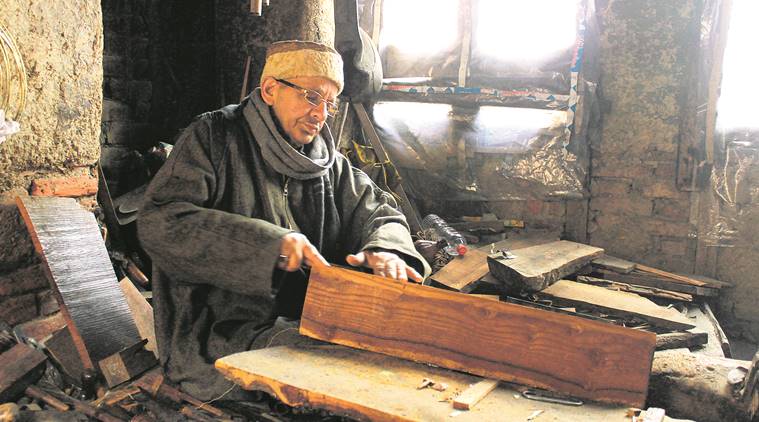Updated: January 9, 2019 8:39:00 am
Santoor maker for Shiv Kumar Sharma, Ghulam Muhammad Zaz is the last in his family of the craft
“We used to engrave it with hangul horns and ivory, but today we use the horns of the sheep. My grandfather would make beautiful floral designs out of ivory," says Ghulam Muhammad Zaz.

Written by Zeenish Imroz
Broken stairs lead to a narrow aisle with mud walls and one enters a small workshop in Zain Kadal, Srinagar. In a small room sits Ghulam Muhammad Zaz, 75, with a trapezoid instrument of a 100-strings, the santoor. He is the last of the eighth generation in his family to carve the classical instrument.
The santoor was brought to Kashmir by the Persians, at the time of poet Shah-e-Hamdan, along with other art forms such as wood carving, shawls and papier-mache. The instrument was incorporated into Sufi music along with the rabab and the sitar, and has become one of the popular instruments used in Indian classical music.
The floor of Zaz’s workshop is covered with dust and iron tools, and there is a rabab and a santoor in the making. “This art was passed on to me by my father, grandfather and uncle, who worked under the name Rahman Joo (Abdul Haliq Zaz) and Sons. I would watch them at work and help them till I learnt it myself. I don’t use any tool for measurements, it is all engraved in my heart and mind,” says Zaz.
About the wood for the santoor, Zaz says, “The wood speaks to me. Earlier, we would craft it out of almond wood. Today mulberry is used because that particular kind of almond wood is not available. The wood must be kept to dry for at least four years to get that tonal quality. It is seasoned twice, once before cutting the log and once after the planks are cut. The planks are joined at specific angles and the finishing is done using different tools. I make the polish myself so that the keys don’t become slippery, and the stick called qalam is made of another type of dried wood, found only in Kashmir. It’s called khatab, and isn’t available in the market anymore.”
In the end, the bridges are placed and three strings are attached. It may take upto three months for him to make a santoor, depending upon his mood and energy. “We used to engrave it with hangul horns and ivory, but today we use the horns of the sheep. My grandfather would make beautiful floral designs out of ivory. The power of this instrument is such that it can seize the hearts of humans as well as birds, like we see Shivji (Shiv Kumar Sharma) doing,” he says. The original Kashmiri santoor went through modifications with Sharma. He improved the tonal quality, changed the ways of playing the instrument, from the stand or squatting before it to taking it on the lap, and tuned it to increase its range. Sharma and Bhajan Sopori, who have taken the instrument to the world stage, use the santoor crafted by him. Sharma’s father (Uma Dutt Sharma) used to experiment with different versions of the santoor, along with Zaz’s ancestors. “There may be santoor makers in the Valley who may have some knowledge of making a santoor, but I guarantee nobody else can craft it like us. It runs in our blood. Our santoors are masterpieces and last a lifetime,” says Zaz, who is the last maker in his family.






















No hay comentarios:
Publicar un comentario